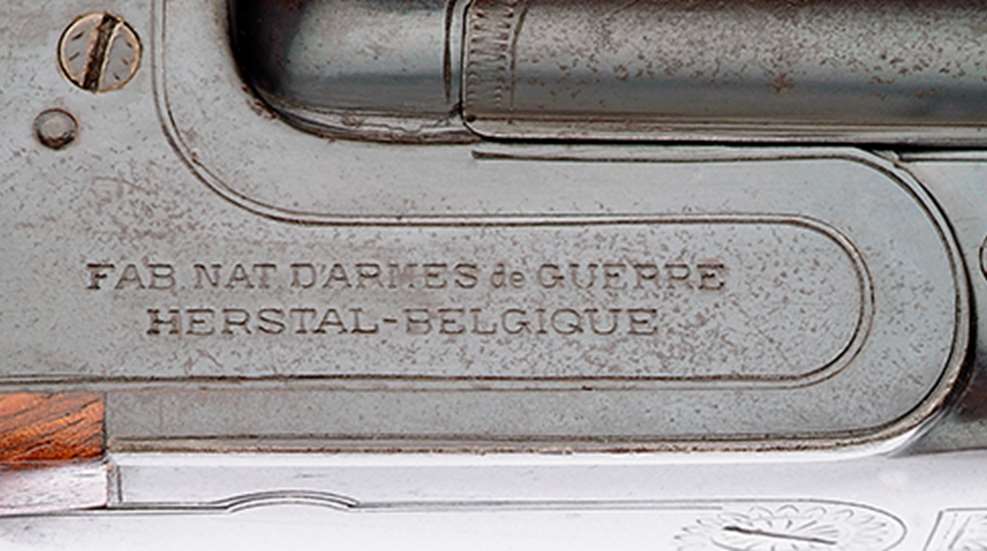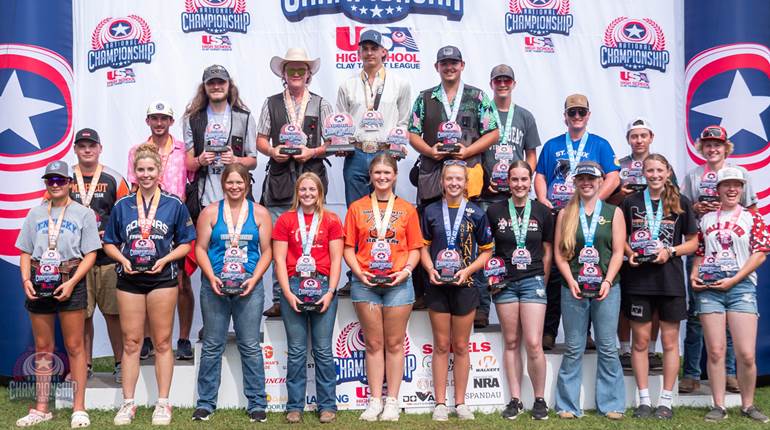
In 1896, Fabrique Nationale faced its largest challenge since incorporating in 1889. What appeared to be a hostile takeover bid, actually resulted in diversification that saved the company. Established to build Mauser rifles for the Belgian government, FN’s competition in the global market for Mauser rifle sales upset the monopoly held by Deutsche Waffen- und Munitionsfabriken-the German Mauser company. Legal battles ensued, and, in the end, the Germans bought a majority of FN’s shares in order to halt the export of FN-manufactured Mauser rifles around the world.
The FN plant lay idle, and Belgian management scrambled to find profitable product lines free of Mauser’s trade restrictions-one option being the manufacture of bicycles. Fortunately, about that time John Browning met FN’s sales manager in Hartford, Conn., and FN’s product line expanded considerably, eventually including bicycles, Browning pistols, parts for rimfire sporting rifles, side-by-side shotguns, automobiles and motorcycles.
Liège, where FN is located, had been an armsmaking hub for centuries. In the late 19th century most Liège gunmakers were small, often family enterprises, and a large percentage of firearms from the area were made and finished by hand. These cottage-industry gunsmiths often purchased parts too elaborate or labor intensive to create by hand. Fabrique Nationale was able to provide high-quality parts at extremely competitive prices due to its extensive use of production line techniques and the factory’s tooling, and that experience was to provide a basis for future product lines. For example, FN’s side-by-side shotgun production developed from late 19th century parts contracts.
In 1903, FN introduced the Browning Auto-5 shotgun. It, like other FN products was marketed through a global network of representatives FN designated as “agents.” Agents, sometimes dispatched from Belgium, were charged with establishing retail and wholesale operations to sell FN products around the world. They were also a key source of market intelligence, reporting product demand to which FN could respond. The FN side-by-side shotgun line arose from agent reports of sales lost when customers wanted more traditional shotguns, rather than the then-revolutionary Auto-5. In response, FN started producing complete side-by-side shotguns shortly after the introduction of the Browning Auto-5. Distribution of side-by-sides was limited to those customers who requested them.
Initial production included sidelocks and boxlocks with Anson & Deeley-type actions. The boxlock was known as Fusil Anson (Anson gun) and the sidelock as Fusil a platinnes (gun with sideplates), and both were made to the same high standards as other FN products. Fabrique Nationale’s facility and manufacturing techniques allowed for the production of high-quality guns at a lower cost than could be provided by competitors. The side-by-side shotguns were offered in a number of grades. A customer could order options and embellishments such as special engraving. Engraving patterns, known as “types,” were standardized by 1910, and depending on the gun, several types were available for purchase. Although sold as premium upgrades, those guns were not as elaborately engraved as those sold by the custom shotgun makers of the same period.
The majority of FN’s side-by-sides were field-grade guns and had simple engraving on the lock and screws. The firm’s marketing approach was to fill a niche, not to compete with custom shotgun makers. That, coupled with a focus on more advanced designs (e.g., the Auto-5), resulted in relatively modest sales.
Commercial production at FN restarted after World War I. Local European market demographics featured many older and more traditional hunters who favored hammer shotguns, and the company was asked if it could supply an old-fashioned side-by-side gun with exposed hammers. (These guns remained popular in Europe, and many manufacturers produced them well into the 1940s; some are produced today.) Hammer guns were favored for safety reasons: Hunters walked with the chambers loaded, only cocking the hammers when game was spotted. The FN employees referred to the hammer guns as “Lefaucheux shotguns,” as they reminded them of old pinfire designs. Although the terminology was incorrect, the gun was known as such internally.
Despite the apparent demand, sales of both sidelock and boxlock guns remained low, and, too, the request for a hammer gun translated to limited sales. The company agreed to supply a hammer gun, but FN outsourced parts manufacture. Depending on production date, hammer guns can be found with either Belgian or German actions or barrels. Fabrique Nationale hammer guns are marked “Mécanise par la Fabrique Nationale d’Armes de Guerre”-which translates to “Mechanized by the National War Weapons Factory.” This indicates that the parts were assembled, fitted and finished at FN but originated from an outside vendor. Hammer guns traditionally have a plain black buttplate instead of the traditional horn FN buttplate, indicating that the furniture may also have been outsourced. Hammer guns were color-casehardened, and they were the only FN guns of the period with such a finish; a clue that these guns were most likely finished outside of FN. Only 2,191 FN hammer guns were sold, making them extremely rare.
FN side-by-sides were offered throughout Europe with the exception of France (protectionist French law prohibited importation of FN’s side-by-side shotguns). The sidelock hammerless gun sold for about 10 percent less than the Anson boxlock. Both models were available in 12 or 16 gauge, with or without ejectors, and were offered with the option of either an English straight stock or a pistol-grip stock (often referred to as a German stock). Barrel lengths were either 28 inches or 30 inches. Agents used FN’s internal name codes for specific configurations. For example, a boxlock shotgun with 28" barrels and pistol grip stock was coded “Spinoze.” Name variances for configurations varied among likewise code names like: Spinrok, Spinstoel, Spintone, Spinloon, Spinulius, Spinach, Spinazie, etc. The code names were often made-up terms or simply words taken from a foreign language. They served to avoid mistakes and confirm the ordered configuration. Custom work and other accessories were available at the customer’s request, but FN did not provide hard cases as standard accessories. Some may have been special-ordered, but the habit of supplying travel cases with maker labels is characteristically British and is usually not associated with continental makers.
Production was intermittent throughout the years due to low sales. Some boxlock actions were purchased from local manufacturers as it was often more economical to outsource a part than to tool up to produce a small batch of parts. In 1930, FN introduced the Model 1930 Sidelock and Model 1930/New Anson (boxlock). They incorporated more modern and cost effective manufacturing techniques but also improvements such as 2¾-inch chambers, stronger barrels and actions tested to higher pressures.
While FN was not in the habit of marking guns under retailers’ names, an exception was made for the German retailer Albrecht Kind, which had sold FN products throughout Germany since the 19th century. These shotguns were sold under Kind’s house brand and marked AKAH (Albrecht Kind aus Hunstig). AKAH guns are easily spotted as they are identical to standard FN production guns and carry the retailer name with Belgian proofs but lack any FN designation.
After John Browning’s death in 1926, the Browning Arms Co. sought to expand its product line and name recognition. Fabrique Nationale’s cooperation with Browning on those efforts is indicated by the existence of a high-grade FN side-by-side made in 1930 and marked with the Browning Arms Co. name bearing serial number 1001. This gun was most likely manufactured as a sales sample in hopes of selling side-by-side shotguns to the Browning Arms Co. Introducing Browning marked side-by-side shotguns to the American market had significant sales potential, but Browning declined, and the engraved sample gun was ultimately sold to FN’s London agent, Louis Lepersonne. In later years American collectors incorrectly believed that this gun was the first side-by-side produced and was designed with Browning influence or under the supervision of Val Browning.
Production of all sporting arms was halted during the German occupation of the factory during World War II. After the liberation, some sporting guns like the Browning Superposed and Auto-5 were assembled on special request by visiting American soldiers, and they were assembled from prewar parts still in inventory. Production of sporting guns resumed in 1946 and included the sidelock. The boxlock was re-introduced in the 1947-1948 timeframe.
Fabrique Nationale sold 32,225 boxlocks, 15,572 sidelocks and 2,191 hammer guns in the pre-war era. Post-war sales were sparse, with only 4,002 boxlocks and 3,702 sidelocks sold up until 1956. In comparison, FN produced more than 700,000 Auto-5 shotguns in the same 1946 to 1955 period, and side-by-side sales were less than one percent of those of the Auto-5.
None of the early FN-made side-by-sides were imported into the United States, and shotguns such as the Browning BSS were introduced in the 1970s, but they were primarily manufactured by Miroku in Japan.
Lack of information has had an influence on the collectability of the early FN shotguns, as they are uncommon in the United States and are usually valued only as curiosities. Collectors praise the quality, but a lack of high-grade guns limits interest with high-end collectors. Some field-grade guns were engraved long after leaving the factory, but they can easily be identified by looking at the factory engraving on the screws, which rarely matches the engraving on the rest of the gun. Factory-engraved shotguns have uniform patterns and engraving themes throughout the gun.
Collectability and values of standard field-grade guns is determined by overall condition, but also by the presence and condition of the original horn buttplate. Any modification or replacement of the buttplate will result in a significant loss of collector value.
Special thanks to Adam Firestone for his contributions to this article.




































